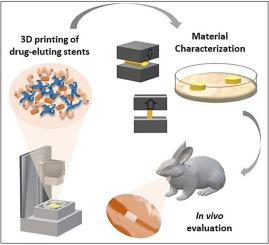当前位置:
X-MOL 学术
›
J. Control. Release
›
论文详情
Our official English website, www.x-mol.net, welcomes your
feedback! (Note: you will need to create a separate account there.)
3D printed drug-eluting stents: Toward personalized therapy for airway stenosis
Journal of Controlled Release ( IF 10.5 ) Pub Date : 2024-11-29 , DOI: 10.1016/j.jconrel.2024.11.031 Adva Krivitsky, Nevena Paunović, Karina Klein, Fergal Brian Coulter, Sarah Schleich, Agnieszka Anna Karol, Aline Bauer, Vadim Krivitsky, Victoria Lohmann, Paula Cendoya Carril, Yinyin Bao, Brigitte von Rechenberg, Cornelia Halin, André R. Studart, Daniel Franzen, Jean-Christophe Leroux
Journal of Controlled Release ( IF 10.5 ) Pub Date : 2024-11-29 , DOI: 10.1016/j.jconrel.2024.11.031 Adva Krivitsky, Nevena Paunović, Karina Klein, Fergal Brian Coulter, Sarah Schleich, Agnieszka Anna Karol, Aline Bauer, Vadim Krivitsky, Victoria Lohmann, Paula Cendoya Carril, Yinyin Bao, Brigitte von Rechenberg, Cornelia Halin, André R. Studart, Daniel Franzen, Jean-Christophe Leroux

|
Airway stents are life-saving medical devices used to treat malignant or benign central airway stenoses. Unfortunately, these devices, typically manufactured from silicone alone and/or nitinol, can result in serious complications, such as stent migration, bacterial colonization, and tissue granulation, eventually forcing stent removal. Customized airway stents exhibit reduced migration and they can be tailored to address other complications by releasing drugs, such as the antibiotic levofloxacin and the antifibrotic drug nintedanib. Herein, the incorporation of these molecules in customized, bioresorbable 3D printed airway stents was investigated. Nintedanib (1.5 wt%) and levofloxacin (2.0 wt%) were incorporated in the polymer-based resin, which was used to 3D print tracheal stents with adequate mechanical and drug release properties. The drug-loaded stents were then deployed into rabbit tracheas and found to deliver the drugs locally with minimal systemic exposure. Drug activities were demonstrated by inhibition of bacterial colonization and reduced interleukin 8 (IL8) local expression. Although the application of these tracheal stents requires further exploration in larger animal models, this work paves the way for the rapid manufacturing of personalized medical devices with therapeutic functions.
中文翻译:

3D 打印药物洗脱支架:气道狭窄的个性化治疗
气道支架是用于治疗恶性或良性中央气道狭窄的救生医疗设备。不幸的是,这些装置通常由硅和/或镍钛合金单独制成,可导致严重的并发症,例如支架迁移、细菌定植和组织肉芽,最终迫使支架移除。定制的气道支架表现出减少的迁移,它们可以通过释放药物(例如抗生素左氧氟沙星和抗纤维化药物尼达尼布)进行定制以解决其他并发症。在此,研究了将这些分子掺入定制的、可生物可吸收的 3D 打印气道支架中。尼达尼布 (1.5 wt%) 和左氧氟沙星 (2.0 wt%) 掺入聚合物基树脂中,用于 3D 打印具有足够机械和药物释放特性的气管支架。然后将载药支架部署到兔气管中,发现以最小的全身暴露在本地输送药物。通过抑制细菌定植和降低白细胞介素 8 (IL8) 局部表达来证明药物活性。尽管这些气管支架的应用需要在更大的动物模型中进一步探索,但这项工作为快速制造具有治疗功能的个性化医疗器械铺平了道路。
更新日期:2024-11-29
中文翻译:

3D 打印药物洗脱支架:气道狭窄的个性化治疗
气道支架是用于治疗恶性或良性中央气道狭窄的救生医疗设备。不幸的是,这些装置通常由硅和/或镍钛合金单独制成,可导致严重的并发症,例如支架迁移、细菌定植和组织肉芽,最终迫使支架移除。定制的气道支架表现出减少的迁移,它们可以通过释放药物(例如抗生素左氧氟沙星和抗纤维化药物尼达尼布)进行定制以解决其他并发症。在此,研究了将这些分子掺入定制的、可生物可吸收的 3D 打印气道支架中。尼达尼布 (1.5 wt%) 和左氧氟沙星 (2.0 wt%) 掺入聚合物基树脂中,用于 3D 打印具有足够机械和药物释放特性的气管支架。然后将载药支架部署到兔气管中,发现以最小的全身暴露在本地输送药物。通过抑制细菌定植和降低白细胞介素 8 (IL8) 局部表达来证明药物活性。尽管这些气管支架的应用需要在更大的动物模型中进一步探索,但这项工作为快速制造具有治疗功能的个性化医疗器械铺平了道路。






























 京公网安备 11010802027423号
京公网安备 11010802027423号